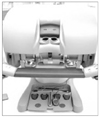Abstract
Nowadays robotics are used in all surgical fields. By increasing the intra-abdominal articulation while operating through a small incision, robotics are increasingly used for a large number of visceral and solid organ operations, including surgery on the gallbladder, esophagus, stomach, intestines, colon, and rectum, as well as for the endocrine organs. As a specialty, robotics should continue to grow. The robotic era enables general surgeons perform more and more complex procedures through small incisions. As technology catches up with our imagination, robotic instruments and 3-D monitoring will become a routine practice and continue to improve the patient care by providing surgeons with most precise, least traumatic ways of treating surgical diseases.
Figures and Tables
References
1. Ballantyne GH, Marescaux J, GIiulianotti PC. Primer of robotic & telerobotic surgery. 1988. Philadelphia: Lippincott Williams & Wilkins.
2. Gill IS, Sung GT, Ballantyne GH. Robotic in surgery. Surg Clin North Am. 2003. 83:15–16.
3. Bargar WL, Bauer A, Borner M. Primary and revision total hip replacement using the Robodoc system. Clin Orthop Relat Res. 1998. 354:82–91.

4. Ballantyne GH, Moll F. The da Vinci telerobotic surgical system: the virtual operative field and telepresence surgery. Surg Clin North Am. 2003. 83:1293–1304.

5. Marescaux J. Code name: "Lindbergh operation". Ann Chir. 2002. 127:2–4.




 PDF
PDF ePub
ePub Citation
Citation Print
Print







 XML Download
XML Download